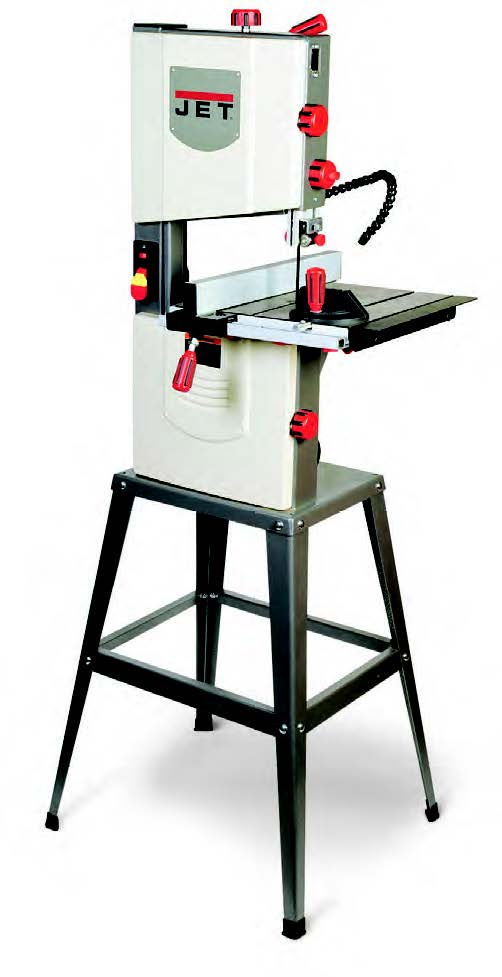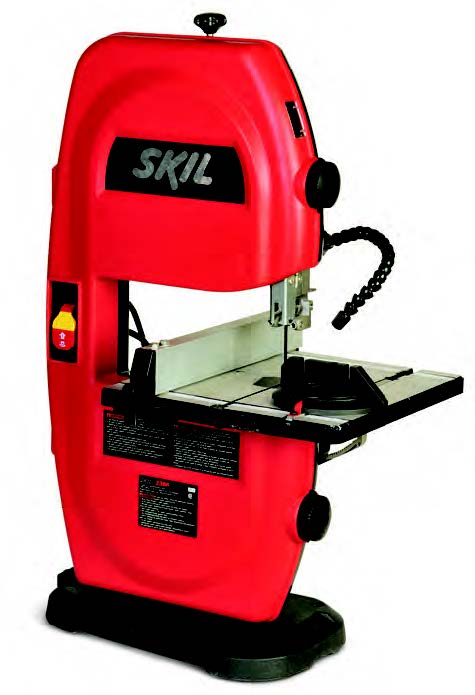Looking for the best small bandsaw? You’ve come to the right place! Whether you’re a beginner woodworker or a seasoned DIY enthusiast, a small bandsaw can be a versatile and valuable addition to your workshop. In this guide, we’ll explore the top contenders in the market and help you find the perfect bandsaw that suits your needs and budget.
A small bandsaw is a powerful tool that enables you to make precise cuts in various materials like wood, metal, and plastic. With its compact size, it perfectly fits in smaller workshops or garages, offering convenience without compromising on performance. But with so many options available, how do you choose the best one? Don’t worry, we’ve got you covered!
In this article, we’ll dive into the key features to consider, such as cutting capacity, motor power, blade versatility, and additional functions. We’ll also provide you with expert recommendations and practical tips to help you make an informed decision. So, let’s get started on your quest to find the perfect small bandsaw that will take your woodworking projects to the next level!

What is the Best Small Bandsaw?
A small bandsaw is a versatile tool that can be used for a wide range of woodworking projects. It allows for precise and intricate cuts, making it a valuable addition to any workshop. However, with so many options on the market, it can be challenging to determine which one is the best small bandsaw for your needs. In this article, we will explore the key factors to consider when choosing a small bandsaw and highlight some of the top picks currently available.
The Importance of Size and Power
When it comes to choosing the best small bandsaw, size and power are crucial considerations. The size of the bandsaw refers to its cutting capacity, or the maximum width and height of the material it can handle. A small bandsaw typically has a cutting capacity of 9 to 12 inches, which is suitable for most hobbyist and DIY projects. However, if you plan on working with larger pieces of wood, you may need to opt for a larger bandsaw with a higher cutting capacity.
In terms of power, the motor size and horsepower of a bandsaw can significantly impact its performance. A more powerful motor will be able to handle thicker and harder materials with ease. Look for a bandsaw with a minimum of 1-1.5HP for optimal performance. Additionally, consider the cutting speed and the ability to adjust it according to the material you are working with. Some bandsaws offer variable speed settings, allowing for greater flexibility and precision.
Comparing the Best Small Bandsaws
Here are three of the top small bandsaws currently on the market:
Bandsaw A: The Perfect Balance of Performance and Price
Bandsaw A is a top choice for those on a budget without compromising on performance. With a cutting capacity of 10 inches and a 1.5HP motor, it can handle a range of materials. Its sturdy construction and adjustable speed settings make it suitable for both precision work and rough cutting. The built-in dust collection system ensures a clean and safe working environment. Overall, Bandsaw A offers excellent value for its price.
Bandsaw A Pros:
- Affordable price point
- Good cutting capacity
- Adjustable speed settings for versatility
- Sturdy construction
- Effective dust collection system
Bandsaw A Cons:
- May require some adjustments and fine-tuning out of the box
- Not suitable for heavy-duty professional use
Bandsaw B: The Compact and Portable Option
If you have limited space in your workshop or need a portable bandsaw for on-the-go projects, Bandsaw B is an excellent choice. With a cutting capacity of 9 inches and a compact design, it can easily be stored or transported. Despite its smaller size, Bandsaw B features a powerful 1.25HP motor and adjustable speed settings. The built-in LED light provides clear visibility, even in dimly lit work areas.
Bandsaw B Pros:
- Compact and portable design
- Powerful motor for its size
- Adjustable speed settings
- Built-in LED light for improved visibility
- Easy to set up and use
Bandsaw B Cons:
- Limited cutting capacity
- Not as suitable for heavy-duty projects
- Slightly higher price compared to other compact models
Bandsaw C: The Professional’s Choice
For those who demand the highest level of performance and precision, Bandsaw C is the ideal choice. With a cutting capacity of 12 inches and a powerful 2HP motor, it can handle even the toughest materials with ease. The large, tilting table allows for angled cuts, perfect for intricate woodworking projects. Bandsaw C also features an advanced blade tensioning system and a smooth operation, making it a favorite among professionals.
Bandsaw C Pros:
- Impressive cutting capacity
- Powerful motor for heavy-duty use
- Tilting table for angled cuts
- Advanced blade tensioning system
- Smooth operation
Bandsaw C Cons:
- Higher price point
- Requires more space in the workshop
- Not essential for casual hobbyists
Choosing the Best Small Bandsaw for Your Needs
Ultimately, the best small bandsaw for you will depend on your specific needs and budget. Consider the size and power requirements of your projects, as well as any additional features that may be important to you. Take the time to read reviews and compare different models to find the perfect bandsaw that suits your woodworking needs. With the right small bandsaw by your side, you’ll be able to take your woodworking skills to new heights!
Key Takeaways: What Is the Best Small Bandsaw?
- A small bandsaw is a versatile tool that is perfect for intricate woodworking projects.
- The best bandsaw for you depends on your specific needs and budget.
- Consider factors such as cutting capacity, blade speed, and durability when choosing a small bandsaw.
- Research customer reviews and ratings to get an idea of the performance and reliability of different bandsaw models.
- Don’t forget to prioritize safety features like blade guards and emergency stop switches when selecting a small bandsaw.
Frequently Asked Questions
Welcome to our frequently asked questions section where we answer some common queries about small bandsaws.
What factors should I consider when choosing the best small bandsaw?
When choosing the best small bandsaw, it’s important to consider a few key factors. First, think about the size and weight of the bandsaw. Opt for a smaller, compact model that can easily fit in your workspace and be moved around if needed. Next, look at the cutting capacity and throat depth. Ensure that the bandsaw can handle the size of materials you typically work with.
Another important consideration is the power and speed of the bandsaw. Choose a model with sufficient horsepower and variable speed settings to accommodate different materials and cutting tasks. Additionally, assess the build quality and stability of the bandsaw, as well as the availability of replacement parts. Finally, read customer reviews and consider the brand reputation to ensure you are purchasing a reliable and durable small bandsaw.
What are the main advantages of using a small bandsaw?
Using a small bandsaw offers several advantages. First and foremost, small bandsaws are compact and portable, making them ideal for small workshops or projects that require mobility. Their smaller size also means they take up less space, allowing you to maximize your workspace.
Small bandsaws also provide greater control and precision when cutting intricate shapes and curves. They excel at making curved and detailed cuts with smooth edges. Additionally, these bandsaws are often more affordable compared to larger models, making them a cost-effective choice for hobbyists or those on a budget. Lastly, small bandsaws are often quieter and generate less vibration, resulting in a more comfortable and enjoyable woodworking experience.
Can I use a small bandsaw for resawing larger pieces of wood?
While small bandsaws are generally not designed for heavy-duty resawing, they can still handle smaller resawing tasks with careful setup and the right blade. It’s important to choose a bandsaw blade with wider teeth and a lower tooth count, specifically designed for resawing. This will help prevent overheating and keep the cut smooth.
Although a small bandsaw may have limited resaw capacity due to its lower horsepower and narrower throat depth, it can still be used to resaw thinner and narrower boards. Just keep in mind that larger pieces of wood may require multiple passes or additional methods to achieve the desired result. If you frequently work with large, thick timbers, it may be worth considering a larger bandsaw specifically designed for resawing.
What safety precautions should I take when using a small bandsaw?
When using a small bandsaw, it’s important to prioritize safety. Start by familiarizing yourself with the user manual and all safety guidelines provided by the manufacturer. Always wear safety glasses or goggles to protect your eyes from any potential flying debris.
Use push sticks or push pads to keep your hands a safe distance from the blade while feeding the material through the saw. Avoid wearing loose clothing or jewelry that could get caught in the machine. It’s also crucial to keep the work area clean and free from clutter to prevent accidents.
How do I maintain and care for my small bandsaw?
Proper maintenance is key to getting the most out of your small bandsaw. Regularly clean the saw, including the table and blade, to remove any debris or buildup that could affect the saw’s performance. Lubricate the moving parts, such as the blade guides and tensioning mechanism, according to the manufacturer’s recommendations.
Additionally, check the tension and tracking of the blade regularly, making any necessary adjustments. Inspect the blade for signs of wear or damage and replace it as needed. Keep the bandsaw properly adjusted and aligned to ensure accurate cuts. Lastly, store the bandsaw in a clean, dry area to prevent rust and other potential damage.

Summary
Looking for the best small bandsaw? Here’s what you need to know. First, consider the size and power of the bandsaw – smaller ones are more portable but may have limited cutting capacity. Next, think about the cutting capacity – you’ll want a bandsaw that can handle the thickness of the materials you’ll be working with. Also, check the blade size and speed – these factors affect the precision and speed of your cuts. Finally, don’t forget about safety features – look for a bandsaw with a blade guard and a reliable stop button. With these factors in mind, you’ll find the best small bandsaw for your needs in no time.
In conclusion, when choosing a small bandsaw, remember to consider the size and power, cutting capacity, blade size and speed, as well as the safety features. These factors will help you find the perfect bandsaw for your woodworking projects. Happy sawing!
